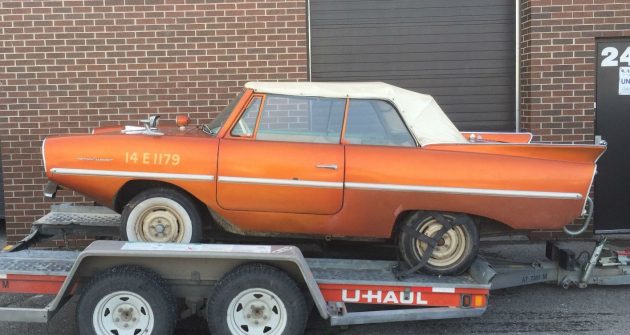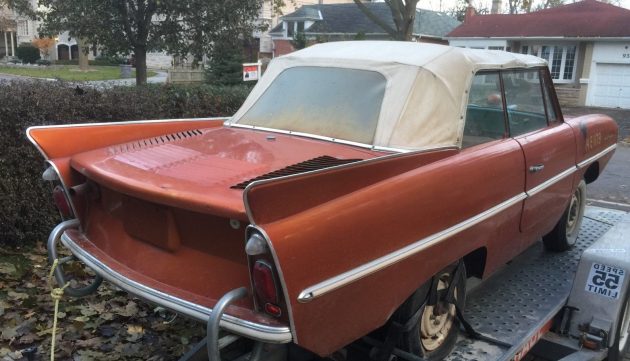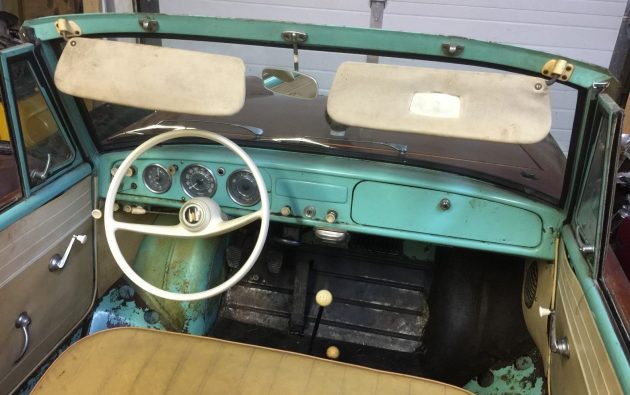There’s just over two hours left on this barn find Amphicar, located in Ontario. These are normally complete rust buckets when discovered, but this one looks quite tidy and is said to have superficial rust only. It has been repainted but finding one in solid condition is the primary goal if you’re looking for a project. Bidding is very light at the moment, and you’ll find the Amphicar here on eBay and bid to around $17K.
$17,000 is no small number for a project, but these amphibious classics have been skyrocketing in value over the last few years. My guess is the lack of good starting points for projects has made even the most borderline examples somewhat desirable, and this one should be going for more (in my opinion) given how sound the body appears from stem to stern. Even the top remains in nice shape and original lenses, glass and bumpers all look quite decent for the age.
Inside, the original fjord green paint remains and reflects what this Amphicar once looked like on the outside. Personally, I don’t mind the orange paint but you can bet this one will be returned to its original color if restored. The interior color of apricot is still visible on the seating surfaces and door panels, and is a striking combo with the light green paint. Google Images shows how it looks with the green exterior and it’s a wonderful change of pace from the typical reds we see on these water-friendly classics.
To me, the Amphicar is immensely appealing as a classic car to own because it hails from an era I don’t think the automobile will soon return to. The idea of Jetsons-like ingenuity was very real, and building a car that could drive on land and water exemplifies that spirit of “What if” perfectly. You could say Tesla is a modern interpretation of that spirit, but it just doesn’t have the character of a wild creation like the Amphicar. The buyer welcomes international bidders, so U.S. customers should give this one a look if in the market.





Good car to sell to a mafiaoso….. so they can visit their friends on the river bottom.
Well, even superficial rust could be a problem with a boat. Got to be pure novelty, as they didn’t do either job well, car or boat. I think people find that out, once they actually buy one. If only it was fiberglass and could pull a skier.
Hey you snuck in a Triumph here, well sorta, being Triumph Herald based. Ahoy mate!!
I agree with Rube. Rust (superficial or otherwise) is something that I probably wouldn’t find desirable on a vehicle that I’m about to drive down a boat ramp and into a lake.
Growing up the local Vet had one. Around here there are a couple of them I’ve seen on the river in summer time. Only comment I have is the time the Vet took his out on the local lake and forgot to put in the drain plugs. It got awfully exciting in a very short time.
I think the Wheeler Dealer episode on the Amphicar is one of their stand outs. It was certainly a worst case scenario for them.
I live in the bay area, this could be fun.
I’d love to take this and add a jetski propulsion system on it. That would be interesting.
This could be the next gimmick vehicle for a Flexseal commercial.
Always wanted one but the draft looks pretty scary from the outside.
I seen the wheeler dealer episode. Theres was about ready to sink when mike took it on the water,lol. What looked like a decent solid body, was a host of horrible patch jobs. They did a very nice fix to it .most I have seen look patched,even this one looks questionable i.e. the front lower portion
Ask the man who owns one! We restored this one from bits and pieces. Get it..you will not regret it.
Sorry if the pic is upside down. Stupid iphone!
I thought it was south of the equator.
Here it is not capsized! :-)
Lol! Thank you!
And they use the term “underwater” for other projects.
So Ontario California but auction in British pounds? Dunno I’m about 260 and wife is minnie mouse, guess I’d have to add some ballast.
Woodbridge, Ontario Canada….use Toronto as the geographic reference point. Nonetheless, odd that it’s not in Canadian or US dollars.
I remember a TV show featuring one of these.The owner said
“It’s a horrible car,& a horrible boat.It does both things equally well”.
Water friendly? For these cars “just barely” should be before those two words.
“I think I’ve flooded the engine.”
Ended: 14 Feb, 2018 22:28:16 GMT
Current bid:£15,200.00
Reserve not met
[ 18 bids ]
I bet it will take at least 30,000 quid to buy this car; it is scary what restored ones have sold for at auction lately.
Having worked on several of these, and done a full restoration on one, I can tell you first hand that if this car was used in a salt water environment, or was allowed to sit in water like a boat, tied to the dock, there is no such thing as “a little rust”. Here’s what we did to test the body of a “fully restored” Amphicar that had not been in the water since the former owner’s restoration. [It had been sold at auction to our customer, but never driven into water since the restoration.] We did this check before we began any exploration of the car or anything to it:
First thing you want to do is obtain a large roll of thick [6 mil or thicker] plastic sheeting. After laying out a large 20X25 foot square of the plastic, first making sure there are no sharp objects underneath [like pebbles], drive the Amphicar to the middle of the sheet, fold up the plastic on the 2 sides of the car, and park 2 large pickup trucks on either side, about 1 foot away from the amphicar. Do the same thing to the front & rear, then slide sheets of plywood along the vehicles before letting the 4 sides of plastic wrap fall into place, anchoring the plastic edges to the 4 vehicles around the car. With someone in the Amphicar, equipped with a bright light [battery operated-you’re dealing with water here], and with the hood & engine cover off, slowly fill the plastic “pool” you’ve created, adding several little containers of red food coloring.
We were not surprised to find small trickles of reddish water coming into the car from areas that looked perfectly water tight. We already knew pinholes in welding seams can lead to steady streams of water when it’s 3 feet below the water line, and as soon as the body begins flexing from the water pressure exerted on the outside of a body panel, filler/putty/bondo starts cracking. Even a crack that you cannot see will leak.
We stripped this nice looking car of everything that could be removed, turned it upside down, & began repairing the newly installed sheet metal. We also found when a rubber seal assembly had to be affixed to the body using sheet metal screws, the first restorers figured the original sheet metal holes would be sealed by the new seal, and they drilled new holes in the body because the top plates to hold the seal in place had holes that didn’t line up to the old holes that were now hidden, now leaked. The reason the holes didn’t line up was because they had the 2 top plates installed wrong!
Or you could do what I did with mine. Pull out the seats and put a hose in the car. Leaks show up really quickly.
4 sure, a lot cheaper than 4 pickup truck, a huge sheet of poly and finding a suitable place.
These sold new in Canada for about $750. So if this guy gets that last bid of 15 grand he will be smiling.
These things often sank. I doubt if top speed on the water would exceed 20 MPH.
So talk of waterskiing behind them is riduculous.
Another Museum piece.
Certainly not worth last bid
https://newatlas.com/amphicars-auction-marketplace-collectible-cars/35375/ says They sold new for between US$2800 and $3300 between 1962 and 1967,
where’s the LS7 guys ?
“Was sinking when parked…” Bill McCoskey’s comments were quite interesting and, frankly, not surprising – thanks for sharing.
I remember seeing a number of these in SoCal when I was a kid. At the time, I thought they were pretty cool.